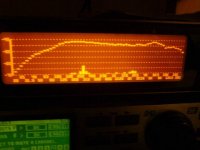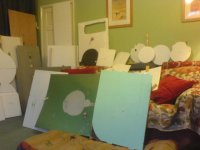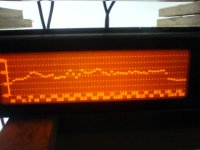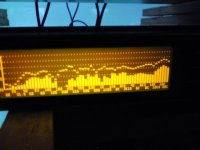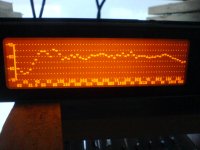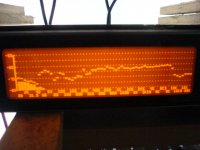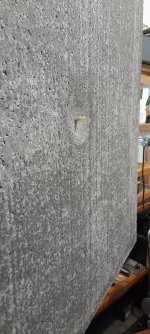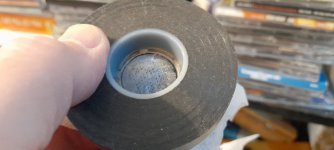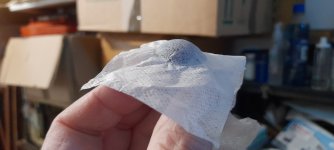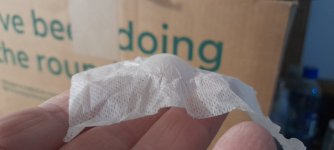Christian.
If you like a smooth response, the first picture is of a thin Ali sheet ply , this was a near field response.
The second picture shows the green very flexible sheet on the floor with the grey stain in the middle.
The third picture is my bog standard 25mm eps large panel using my TLs below 250hz at a distance of 3m , with a very flat response from 250hz up to 10k.
All pictures taken from the nxt RUBBISH forum ,which were posted 10 years ago.
The thin sheet aluminium sounded smooth ,some might call it boring 😄
But then a lot of high end audio does sound smooth, some find this desirable?
Not me.
Steve.
If you like a smooth response, the first picture is of a thin Ali sheet ply , this was a near field response.
The second picture shows the green very flexible sheet on the floor with the grey stain in the middle.
The third picture is my bog standard 25mm eps large panel using my TLs below 250hz at a distance of 3m , with a very flat response from 250hz up to 10k.
All pictures taken from the nxt RUBBISH forum ,which were posted 10 years ago.
The thin sheet aluminium sounded smooth ,some might call it boring 😄
But then a lot of high end audio does sound smooth, some find this desirable?
Not me.
Steve.
Attachments
This was the heavily framed 3mm ply at 1m ,dotted line , and with the microphone at 3m average peak hold thick yellow showing the 200hz such out in the room.
Notice the above 10k hf hump.
I thought I might as well show the 25mm eps at 12inches and at 12ft ,pictures 2 and 3.
Notice the roon affect in the 200hz area again.
Which are sorted by the TLs rolling off before 300hz, see previous post.
Steve.
Notice the above 10k hf hump.
I thought I might as well show the 25mm eps at 12inches and at 12ft ,pictures 2 and 3.
Notice the roon affect in the 200hz area again.
Which are sorted by the TLs rolling off before 300hz, see previous post.
Steve.
Attachments
Christian.Thank you Steve
Sorry to answer late... so important activities on going those days!
I have digitized your measurements. In other words enter manually the estimated values I read on the pictures in a spread sheet.
Here are the 2 curves
View attachment 1083660
Here is their differences (blue) and a tentative of smoothing (red)
View attachment 1083663
I don' know what to think about it except that quickly the attenuation is around 6dB (from 200Hz) to come near 9dB from 2k and then increasing above 10/12k.
The loss in HF was expected but the loss from 200Hz less...
Does it mean the wave don't travel far in EPS?
In my last post based on outdoor measurements, EPS shown an higher damping than the 2 other "competitors" 'XPS, plywood)
Christian
Attached the pdf of the OpenOffice file; Let me know if you want the OO or xls version.
The response at 18cm was only to demonstrated higher output in the exciter area(primary drive area). this will always be louder than the surrounding panel area's.
A single point microphone measurement at that 18cm point only tells you the output at that 18cm point, if you move the microphone by 1 or 2 cm this measurement could and probably would totally change.
It is the chaotic nature of dml.
It is only the total output from the combined cm of the whole panel surface that gives you your in room response.
Not forgetting that the rear of the panel should be a mirror image (negative) of the front surface.
The measurements in the primary drive area, show the output of the coil and panel surface in the exciter area, similar to if you were measuring a cone speaker in a baffle.
Everything beyond this area is bendingwave then dml ,in that order.
Some panels, such as eps are more efficient in the primary drive area than others, with direct output from this area into the air.
I usually, with my 25mm eps, thin the area in front of the exciter coil area to match a cone shape, for a more intimate sound.
As in this picture of the graphite eps panel.
Steve.
Attachments
Steve:
A visit to my overfull garage yielded two 1200x 600 sheets of 5mm Corflute.😱
A trip to my desk yielded some recently arrived Dayton Exciters...😁
The workshop gave me some masking tape👍
A short amount of work gave me some working test panels😃
I first tried a 20w unit, then the 40w directed flux unit
Both drove the full panel but the 40w unit trumps of course
I'm surprised and hopeful that something worthwhile can come from this 😁
Even though I just guessed and stuck, the sound quality is very good.
The bright end is not quite there but it may be because of the panel size.
Brings me to my question regarding your fabric domes
Can you please describe the process of making these
I made some a while ago using multi layers of glued stocking material stretched over a kitchen measuring spoon.. Worked ok but I figure you will have a different method.
Also I'm thinking that apart from a dome, some way of filling the voids immediately in the voice coil zone with some lightweight substance would bring the brights to the front
Hmmmm
Polypropylene is also difficult to glue and paint... Hmmmm again
Cheers
Eucy
A visit to my overfull garage yielded two 1200x 600 sheets of 5mm Corflute.😱
A trip to my desk yielded some recently arrived Dayton Exciters...😁
The workshop gave me some masking tape👍
A short amount of work gave me some working test panels😃
I first tried a 20w unit, then the 40w directed flux unit
Both drove the full panel but the 40w unit trumps of course
I'm surprised and hopeful that something worthwhile can come from this 😁
Even though I just guessed and stuck, the sound quality is very good.
The bright end is not quite there but it may be because of the panel size.
Brings me to my question regarding your fabric domes
Can you please describe the process of making these
I made some a while ago using multi layers of glued stocking material stretched over a kitchen measuring spoon.. Worked ok but I figure you will have a different method.
Also I'm thinking that apart from a dome, some way of filling the voids immediately in the voice coil zone with some lightweight substance would bring the brights to the front
Hmmmm
Polypropylene is also difficult to glue and paint... Hmmmm again
Cheers
Eucy
Last edited:
No such (detailed) comparison exists that I am aware of. But maybe these posts can help to get started:Hey guys,
I've read lots of posts on this thread, but not the entire 321 pages, and I couldn't find a comparison of the different exciters brand available.
https://www.diyaudio.com/community/...s-as-a-full-range-speaker.272576/post-5941985
https://www.diyaudio.com/community/...s-as-a-full-range-speaker.272576/post-6213432
Eucy.
Are the flutes square or round ?
I would think that inserting a material into the flutes in the exciter area would damp the hf rather than increase it ?
The hf would increase when rigidly glued to the panel.
the tests I made regarding the hump in the response along the flutes seems to point the the surface of the flutes.
I covered up the ends of the flutes and the hump was still there, the hump on the thicker round proplex was lower down as in the previous photo.
But the 4mm square proplex was higher up in the 10k area.
But only along the flutes that the exciter was glued onto.
so make of that as you will ?
The fabric dome was to help vent the coil cavity, and help prevent distortions within the coil surface area , not necessarily as a tweeter, although it can do this also ?
With flutes ,this is a problem , as drilling a large deep hole in the flutes and somehow attaching a dome on the surface or on the coil foot , ? I have not figured this out , how it could work ?
Although the response with the exciter firmly glued on might solve the problem , as my measurements don't seem to show any serious peaks and dips, that is if your panel has a similar response to mine ?
Maybe a separate piezoelectric tweeter might be necessary or even preferable ?
1mm flutes are manageable , and I do have a small 1mm card with flutes, which I will demonstrate how I do it , but I intend ,hopefully to try using a thin teabag material this time , first of all, just to see if it works ?
Steve.
Are the flutes square or round ?
I would think that inserting a material into the flutes in the exciter area would damp the hf rather than increase it ?
The hf would increase when rigidly glued to the panel.
the tests I made regarding the hump in the response along the flutes seems to point the the surface of the flutes.
I covered up the ends of the flutes and the hump was still there, the hump on the thicker round proplex was lower down as in the previous photo.
But the 4mm square proplex was higher up in the 10k area.
But only along the flutes that the exciter was glued onto.
so make of that as you will ?
The fabric dome was to help vent the coil cavity, and help prevent distortions within the coil surface area , not necessarily as a tweeter, although it can do this also ?
With flutes ,this is a problem , as drilling a large deep hole in the flutes and somehow attaching a dome on the surface or on the coil foot , ? I have not figured this out , how it could work ?
Although the response with the exciter firmly glued on might solve the problem , as my measurements don't seem to show any serious peaks and dips, that is if your panel has a similar response to mine ?
Maybe a separate piezoelectric tweeter might be necessary or even preferable ?
1mm flutes are manageable , and I do have a small 1mm card with flutes, which I will demonstrate how I do it , but I intend ,hopefully to try using a thin teabag material this time , first of all, just to see if it works ?
Steve.
Last edited:
SteveEucy.
Are the flutes square or round ?
I would think that inserting a material into the flutes in the exciter area would damp the hf rather than increase it ?
The hf would increase when rigidly glued to the panel.
the tests I made regarding the hump in the response along the flutes seems to point the the surface of the flutes.
I covered up the ends of the flutes and the hump was still there, the hump on the thicker round proplex was lower down as in the previous photo.
But the 4mm square proplex was higher up in the 10k area.
But only along the flutes that the exciter was glued onto.
so make of that as you will ?
The fabric dome was to help vent the coil cavity, and help prevent distortions within the coil surface area , not necessarily as a tweeter, although it can do this also ?
With flutes ,this is a problem , as drilling a large deep hole in the flutes and somehow attaching a dome on the surface or on the coil foot , ? I have not figured this out , how it could work ?
Although the response with the exciter firmly glued on might solve the problem , as my measurements don't seem to show any serious peaks and dips, that is if your panel has a similar response to mine ?
Maybe a separate piezoelectric tweeter might be necessary or even preferable ?
1mm flutes are manageable , and I do have a small 1mm card with flutes, which I will demonstrate how I do it , but I intend ,hopefully to try using a thin teabag material this time , first of all, just to see if it works ?
Steve.
The flutes are square.
I believe it's important for the exciter to have as direct a contact with the front radiating surface as possible. There's a paper somewhere which examines the loss of hf through distortion in the voice coil former by compressive forces, and I think the same is happening in the thin ribs of these sheets in the coil area.
If it was possible to inject expanding foam locally it would work I think.. Have to think on it. Cutting a hole will damage the flexural properties I think, particularly given the ribbed structure and polypropylene's bonding properties
As for the hump, I ran my ear along the open flutes and yes, there's a distinct increase in volume at the end of the flutes along the line of the exciter. Stands to reason.. They're acting like an acoustic tube. Maybe it favours certain frequencies depending on the tube length (distance from the exciter to the edges). I taped up a section and it seemed to decrease it
Dome..So how do you form the dome from tea bag material?
Eucy
Eucy.
I just quickly made up this dome, I was concentrating on the dome when I should have been concentrating on cc, corrugated card and water doesn't go well together, this panel was an old panel coated in egg whites, I should of coated it in a thin layer of pva to stop it soaking in 😕
The first pic is of some of the tools I use.
Pic 2 is a marble I use for the dome shape.
3 the marble and tea bag.
4 and 5 the dome and marble before gluing.
6 ,7,8 is applying the pva to the card and dome base.
9 is the dried dome.
10 is the sorry state of the cc.
11 , this side looks a lot nicer.
12. I would probably fill these gaps at the edges with neat pva.
It would probably been better gluing the dome onto the front, and paying more attention to the cc.
Steve.
I just quickly made up this dome, I was concentrating on the dome when I should have been concentrating on cc, corrugated card and water doesn't go well together, this panel was an old panel coated in egg whites, I should of coated it in a thin layer of pva to stop it soaking in 😕
The first pic is of some of the tools I use.
Pic 2 is a marble I use for the dome shape.
3 the marble and tea bag.
4 and 5 the dome and marble before gluing.
6 ,7,8 is applying the pva to the card and dome base.
9 is the dried dome.
10 is the sorry state of the cc.
11 , this side looks a lot nicer.
12. I would probably fill these gaps at the edges with neat pva.
It would probably been better gluing the dome onto the front, and paying more attention to the cc.
Steve.
Attachments
-
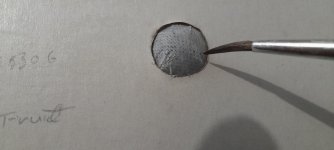 20220824_141109.jpg242.7 KB · Views: 97
20220824_141109.jpg242.7 KB · Views: 97 -
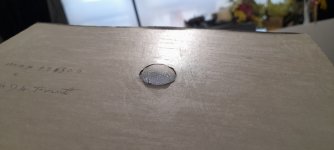 20220824_140929.jpg210.5 KB · Views: 100
20220824_140929.jpg210.5 KB · Views: 100 -
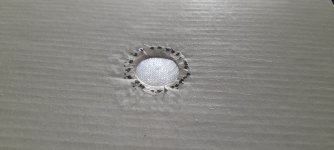 20220824_140917.jpg264.1 KB · Views: 104
20220824_140917.jpg264.1 KB · Views: 104 -
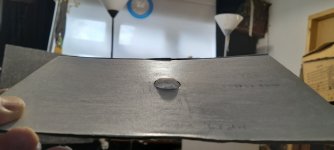 20220824_140409.jpg215.5 KB · Views: 101
20220824_140409.jpg215.5 KB · Views: 101 -
 20220824_140153.jpg179.4 KB · Views: 101
20220824_140153.jpg179.4 KB · Views: 101 -
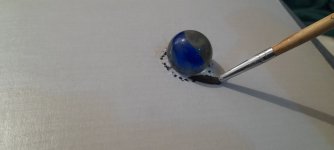 20220824_140005.jpg182.4 KB · Views: 110
20220824_140005.jpg182.4 KB · Views: 110 -
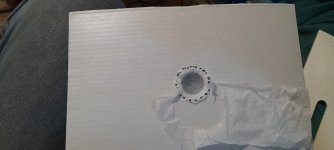 20220824_135734.jpg277.8 KB · Views: 94
20220824_135734.jpg277.8 KB · Views: 94 -
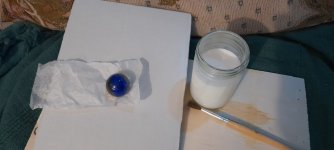 20220824_134843.jpg216.7 KB · Views: 99
20220824_134843.jpg216.7 KB · Views: 99 -
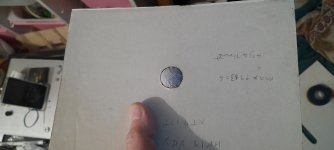 20220824_133205.jpg189.9 KB · Views: 104
20220824_133205.jpg189.9 KB · Views: 104 -
 20220824_133118.jpg263.7 KB · Views: 96
20220824_133118.jpg263.7 KB · Views: 96 -
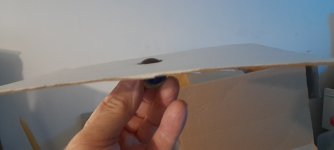 20220824_132307.jpg189.5 KB · Views: 97
20220824_132307.jpg189.5 KB · Views: 97 -
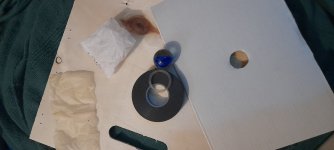 20220824_131825.jpg244.3 KB · Views: 102
20220824_131825.jpg244.3 KB · Views: 102
Eucy.
One again it has changed the order of the pictures, when uploaded.
Now in revers order !!
Steve.
One again it has changed the order of the pictures, when uploaded.
Now in revers order !!
Steve.
Hi Eucy, I used hot glue on Polypropylene with my exciter. It works very well.Polypropylene is also difficult to glue and paint... Hmmmm again
Apply the glue on the board instead of the exciter ring. If direct apply the glue on the ring, over heat may melt the ring and distort it.
To remove the exciter, use hair dryer at mid-heat under 70c with patient.
Ok... Understand... Thanks Steve.. Similar approach to mine with different material... The stocking stretches nicely without wrinkling but I had to use about 5 layers from memory... It was still very light though...I used acrylic lacquer spray as the glue.Eucy.
One again it has changed the order of the pictures, when uploaded.
Now in revers order !!
Steve.
Eucy
Thanks hkguy6... It will need to be a flexible chewy sort of glue for this material... I'm not sure if I could get a hot melt glue layer thin and even enough though?Hi Eucy, I used hot glue on Polypropylene with my exciter. It works very well.
Apply the glue on the board instead of the exciter ring. If direct apply the glue on the ring, over heat may melt the ring and distort it.
To remove the exciter, use hair dryer at mid-heat under 70c with patient.
Hello Eucy,Thanks hkguy6... It will need to be a flexible chewy sort of glue for this material... I'm not sure if I could get a hot melt glue layer thin and even enough though?
Today going to a DIY store for some stuff to organize my workshop area, I added in my basket a sheet of transparent polypropylene. 4mm thick with square flute. As it was not the priority of the days, it lays for now in my garage waiting for a time to do some test but also mainly for gluing method.
What method have you used?
As you said, it is polypropylene with is not the best friend for glue. I have in mind that Steve sanded the surface and have used PVA, hgkguy6 have just suggested hot glue applied on the panel. I wouldn't want to damage the exciter in the operation.
Christian
@Eucyblues99Hello Eucy,
Today going to a DIY store for some stuff to organize my workshop area, I added in my basket a sheet of transparent polypropylene. 4mm thick with square flute. As it was not the priority of the days, it lays for now in my garage waiting for a time to do some test but also mainly for gluing method.
What method have you used?
As you said, it is polypropylene with is not the best friend for glue. I have in mind that Steve sanded the surface and have used PVA, hgkguy6 have just suggested hot glue applied on the panel. I wouldn't want to damage the exciter in the operation.
Christian
I think you have already explained it : your post #5741
Browsing on "how to glue polypropylene" : I see that Loctite claims its Loctite plastic with its primer works with polypropylene. I have some so easy to test. The problem is it is a strong glue... if ok for final use (do we have that?), it is not for testing. A solution might be to glue so intermediate material... some idea of which material and then which glue or tape to the exciter?
Christian
Hi Christian@Eucyblues99
I think you have already explained it : your post #5741
Browsing on "how to glue polypropylene" : I see that Loctite claims its Loctite plastic with its primer works with polypropylene. I have some so easy to test. The problem is it is a strong glue... if ok for final use (do we have that?), it is not for testing. A solution might be to glue so intermediate material... some idea of which material and then which glue or tape to the exciter?
Christian
Are you sure you bought polypropylene and not polycarbonate?...Although you can get a clear grade, Polypropylene is usually a milky white or coloured
The transparent stuff is commonly the carbonate variety... Considerably glassier and stiffer than the propylene. Worth checking ..Thought I'd ask anyway
I have the Loctite primer in my workshop and have used it with super glue on poly previously but not on a vibrating panel.
I think the styrene based glue I have will probably work on a prepared surface. A good quality PVA glue may also be ok
I also have in mind a product which is sold as a sealant but which I have found to be an excellent special purpose adhesive
Here it's called 'All Clear' and is sold by Selleys. It's very sticky, can be scraped thinly and sticks tenaciously to just about anything
https://www.selleys.com.au/products/sealants/selleys-all-clear/
Cheers
Eucy
Last edited:
This dome is very thin and light, it will be interesting how it sounds and measures .Ok... Understand... Thanks Steve.. Similar approach to mine with different material... The stocking stretches nicely without wrinkling but I had to use about 5 layers from memory... It was still very light though...I used acrylic lacquer spray as the glue.
Eucy
I will glue the second dome to an exciter coil foot ,without the panel .
I only used the 50x50 pva mix , but it still feels quite hard and solid.
I thought it might be a bit softer.
Like a fabric dome.
I may have to go back to the thin cotton sheeting.
Steve.
Just mark a circle on the board. Apply the hot glue in circle. Put the exciter on it and apply pressure quick. Pressure will make the glue thin.Thanks hkguy6... It will need to be a flexible chewy sort of glue for this material... I'm not sure if I could get a hot melt glue layer thin and even enough though?
If your hands didn't quick enough. Hair dryer to warm up the board first may help.
Ok thanksJust mark a circle on the board. Apply the hot glue in circle. Put the exciter on it and apply pressure quick. Pressure will make the glue thin.
If your hands didn't quick enough. Hair dryer to warm up the board first may help.
- Home
- Loudspeakers
- Full Range
- A Study of DMLs as a Full Range Speaker
